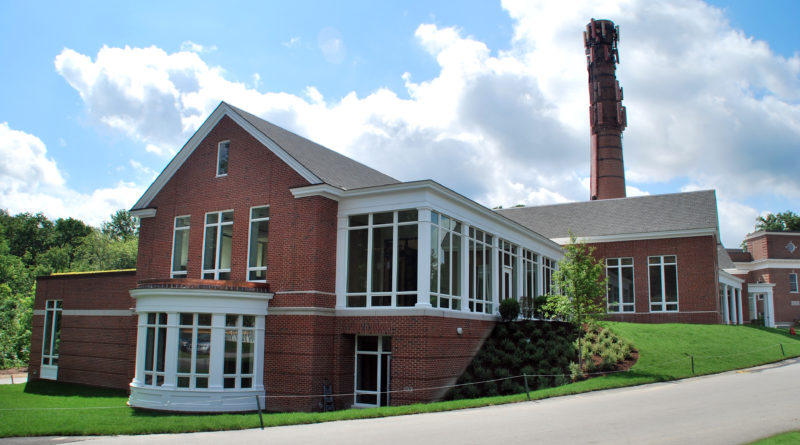Rachel Carson Music & Campus Center Was Built Around a Smokestack
CONCORD, Mass. — When it comes to the Rachel Carson Music and Campus Center, there’s “adaptive reuse projects,” and then there’s converting elements of a 19th century steam plant into a 22,000-square-foot campus performing arts center without toppling a beloved 100-year-old smokestack.
The recently completed center, named for the famous conservationist, features a 134-seat, state-of-the-art recital hall along with practice spaces, classrooms and gathering spaces. After years in the basement of the school’s library, the Middlesex School music program has essentially quadrupled its space. The adaptive reuse project led by Windover Construction, based in Beverly, Mass., turned the campus’ old steam plant into a state-of-the-art music facility to match the school’s high caliber programming.
Having experienced expansive growth in its music and performing arts program, Middlesex was in need of dedicated music instruction, practice and performing spaces. As a trusted partner for campus projects, Middlesex turned to Windover to manage the preconstruction and construction for this project in close collaboration with Boston-based CBT Architects.
Converting a former steam plant into a state-of-the-art music center wasn’t without its challenges, however. “The conversion was challenging because structurally what remained of the existing building had to be stabilized with bracing and underpinning in order to integrate the new structure and construction,” said Stuart Meurer, executive vice president and chief operating officer of Windover Construction.
Among the unique issues facing the project was respecting the aesthetic integrity of the building while implementing contemporary construction practices — not to mentioned preserving the iconic smokestack that has long festooned the building’s profile.
“The only part of the existing steam plant that still visually remains is the smokestack, which offers the building a very unique visual element,” said Meurer.
The campus community was unanimous in its desire to keep the smokestack, which ventilated a steam plant originally fueled by coal. The plant provided heat and domestic hot water to the growing campus via an elaborate, underground network of steam lines. After WWII, the plant switched to heating oil as its primary source of fuel. In the 2000s, long-term deferred maintenance of the campus heating system as well as the economic and environmental impact of the central steam plant against, led to a transition to natural gas as a fuel source and a decentralization of the entire campus heating infrastructure.
“This investment eliminated the need for further maintenance of the aging steam pipe and heat exchanger network and dramatically improved the efficiency of the system,” said Middlesex School Chief Operating Officer Matthew E. Crozier. “This switch helped the school reduce its overall carbon footprint by 25 percent, eliminating nearly 1,000 tons of CO2 from the atmosphere each year.”
The new upgrades follow upon this early green initiative. Throughout the reimagining of the structure, Meurer and his team took the opportunity to implement several green-themed upgrades, which is to be expected given the fact that the building’s namesake, the Rachel Carson Music and Campus Center, honors Carson’s early pioneering in the areas of marine biology and conservation. Among the new elements are three geothermal wells that provide for the building’s heating and cooling as well as a green roof and LED lighting throughout.
To make for a ready-to-use performance theater, Windover worked with Marvin Windows and View Dynamic Glass on the ionized window glazing or “dynamic glass,” which automatically tints to limit solar gain and provide environmental control. Windover also worked with theater consultant, Martin Vinik, and Boston-headquartered acoustic consulting firm, Acentech, to perfect the layout and acoustics of the space. The result is a performance center that its booster say rivals Massachusetts’ other prestigious music institution, the Berklee School of Music.
“As always, we work to have our program drive the spaces we create — not the other way around,” said Crozier. “We are a school of 400 students — medium sized in our market — and not committed to dramatic growth in that student population.”
That said, the school’s music program has grown dramatically over the past 20 years and boasts more than 150 students every year.
“For us, the new space was built to address the programmatic needs those students have,” said Crozier, who points to increased practice rooms, flex spaces and a performance venue dedicated to choral and instrumental music among the improvements. “We also have five humanities classrooms in the building, and that is where the flexibility and future-proofing come in. Today, we use those spaces for Spanish classes to give the building a broad range of use. If, in the future, our music program were to grow further — a summer institute, for example — we could transition those spaces easily to music use.”

